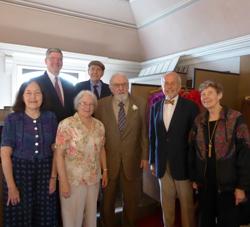
Robert C. Newton retired in June 2016 after 53 years at Andover Organ Company, Methuen, Massachusetts. He started at Andover on January 3, 1963. He purchased shares in the company in 1975 and later served as treasurer and vice president of the Old Organ Department. Newton worked on hundreds of historic organs and oversaw Andover’s restorations of many Hook instruments.
On July 9, 2016, Newton was honored at a concert featuring six organists playing selections by some of his favorite composers on an historic organ that he restored: the 1866 E. & G. G. Hook Opus 396 at the First Presbyterian (Old South) Church in Newburyport, Massachusetts. A highlight of the concert was the reading of a letter from Christopher Marks, president of the Organ Historical Society, awarding Newton an honorary life membership in the Society in recognition of his many years of work in preserving and documenting numerous historic American organs. Following the concert there was a reception to celebrate the organ’s 150th birthday and Newton’s 77th birthday, which was on that day. Newton will continue to serve on Andover’s board of directors.
Photo: Robert Newton (center) with concert organists Rosalind Mohnsen, Kevin Birch, Permelia Sears, Thomas Murray, Brian Jones, and Lois Regestein (photo credit: Matthew Bellocchio)


